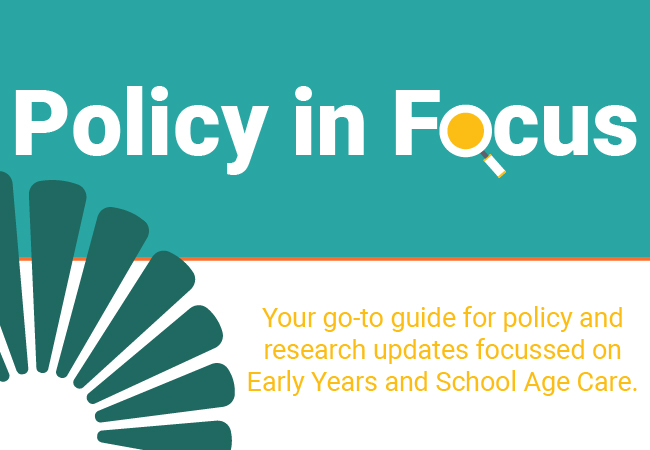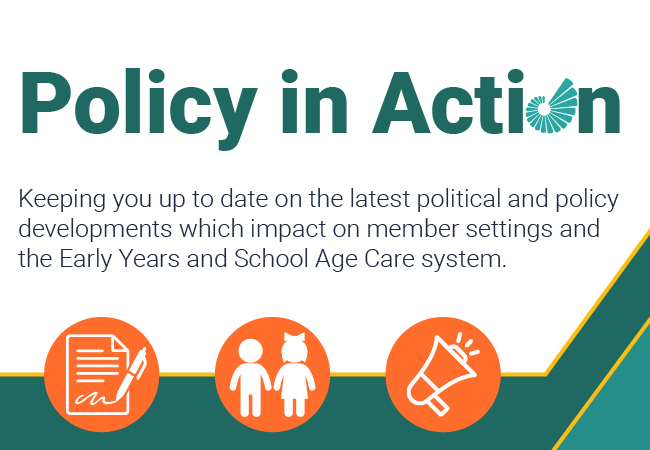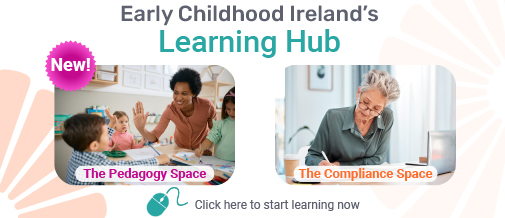Response to the Public Consultation
Early Childhood Ireland’s vision as laid out in ‘Playing Our Part – Strategic Plan 2015-2020‘ is that ‘every young child is thriving and learning in quality early childhood settings’. Our role in achieving this vision is to be effective champions for quality in practice, putting children and their rights at the core of our work and advocating strongly for them, their families and all early childhood professionals.
We therefore welcome the opportunity to join in and contribute to the national conversation on the accessibility, affordability and quality of early years and school age care and education. We feel that that short turnaround time of two weeks, from mid to the end of April, is a very real challenge to engagement. For many educators, who are at a critical time with studies at Levels 5, 6, 7 and 8, the time frame is extremely tight. In relation to parents, the lead in time, whereby this consultation comes to their attention and the time required for thinking and responding, limits a significant opportunity to connect with policy makers.
This consultation is important to us in Early Childhood Ireland. We believe that the sector is at a tipping point and that this year offers a real opportunity for positive, systemic, long term change. With that in mind, Early Childhood Ireland conducted a series of provincial focus groups with members, week beginning 27th April. Members who attended were knowledgeable, committed and passionate, coming from both the private and community sector, delivering sessional, full day and school age childcare.
1. Objectives of, and core principles for, investment
A. Objectives for investment
Members uniformly prioritised children and families as being the primary objective of future investment (‘Promoting child development and well-being’ and ‘Encouraging and/or supporting parenthood’ followed by ‘Improving incomes of disadvantaged families or reducing their expenditures’). This response speaks to the centrality of children and families and the recognition that this is the starting point. The strength and consensus from the sector on this point aligns with the commitments of Better Outcomes/Brighter Futures and with Right from the Start, a Report from the Expert Advisory Group on The Early Years Strategy. While investment may support gender equality and labour force participation, investment in early childhood care and education is seen and understood by members as ‘a common good’.
B. Core principles for investment
There was a unanimous belief amongst members that in crafting principles ‘Quality’ followed by ‘Evidence-based’ were of primary importance. While members recognised and valued all the principles outlined, many were understood as being features of a system that is fit-for-purpose, rather than core tenets. In other words, accountability, stability and transparency are in many ways administrative functions of a competent system. For us, quality linked to funding or funding linked to quality based on reliable evidence are beliefs that would ensure children have worthwhile and meaningful early learning opportunities based on the best knowledge and research available. For parents these principles suggest a confidence in the quality of care and education for their children which allows them confidently work, train or study. From an investment perspective, research is unequivocal that only quality counts and less than quality is potentially damaging. There is also a clear feeling that a core principle for investment, in addition to those listed, should include a reference to the child – Investment in early childhood should foreground and be underpinned by the rights of the child.
2. Review and reform of current investment
A. Direct DCYA investment
Strengths
There is a clear acknowledgement of the value of the schemes that are directly funded through DCYA, in particular the ECCE scheme which is universally available. Members applauded the DCYA in the high level of uptake of the scheme, particularly in light of GUI findings where 25% of parents reported that without the free preschool year their child could not have attended an early childhood setting. The ECCE scheme represented a ‘life saver’ in terms of cash flow during a very difficult economic phase, where occupancy levels were uncertain. The introduction of the Higher Capitation level as a development of the ECCE scheme is understood as a first step in signalling a graduate led workforce. The focus of investment directly into services/setting (funding following the child) builds the ongoing capacity and quality of the sector for the common good, rather than individual tax breaks which are understood as less effective (OECD, 2006). There was also a strong feeling that, despite challenges in administration, the TEC schemes have begun to remove barriers for children and families, through their availability across the private/community sector.
Members value the investment in the infrastructure which is evidenced through the support from CCCs and the National Voluntaries. Overall the strengths of the current direct investment is that a foundation has been laid, from which a new model must now emerge.
Weaknesses
The overarching weakness in the current system of investment is simply that the levels of funding and subsidisation into the sector are too low and do not recognise the complexity of demands and costs in operating quality settings. The sector has a strong sense of ‘firefighting’ from government departments and agencies and is calling for a plan which allows them project out over a 3-5 year period. The sense of firefighting emerged across all member groups- the speed with which the learner fund was introduced and the consequential challenges; the introduction of the PIP system going live and the accompanying problems; difficulties with late payments where cash flow and margins are so tight are but a few examples.
Schemes
Investment in the range of schemes is understood as a key mechanism to support children and families; to enable the delivery of services and to drive quality. However, the schemes in the current format are not fit for purpose.
- Contracts and terms and conditions for staff are problematic. Contracts of 38 week duration do not create sustainable jobs for the workforce and fail to create stability, consistency or certainty in the services that wish to retain their qualified staff.
- The levels of capitation and the scope of the schemes do not allow for child free hours and does not facilitate CPD, both of which are vital to a quality agenda. The levels of capitation for each of the schemes does not support sustainability and has led many members into a situation of reckless trading.
- Broader than the DCYA schemes, the issue of self-employed providers who take the risk and invest in the their business, who carry overheads over 52 weeks of the year and yet who cannot access any social welfare supports is a very real weakness in a system which relies heavily on the private sector to roll out government schemes.
- Lack of access to all funding schemes for all services (private/community) which would allow parents greater choice in choosing childcare, promote greater social integration and minimise any stigma attaching to specific settings.
- Currently, services that have multiple ECCE rooms must have the leader in each room with a Level 7/8 to qualify for higher capitation. This ‘all or nothing’ approach acts as a disincentive for services to gradually build up the number of higher qualified leaders in the ECCE service.
- Current investment into childminding and school age provision is not currently evidence based or linked with regulation, standards or inspections, which raises questions of accountability, transparency and value for money. Consequently, there is a need to introduce regulations and inspections in both child minding and out of school provision.
- The levels of paperwork and reporting requirements are overly onerous, with many settings having to invest in introducing and upgrading technology (investing funds they do not have in programmes and software, anti-virus packages, broadband packages, training for staff, printing costs).
Workforce
- A significant weakness in the aspiration for a graduate led sector with realistic subvention or supports is the absence of a mechanism to ensure higher capitation is linked to salaries and that those with higher qualifications earn more.
- The limitations of the Learner Fund – support for higher qualifications at levels 7 and 8 are ineligible and yet there is a strong appetite in the sector to progress in anticipation of emerging career pathways.
- Room leaders only are eligible for Level 6 support which does not allow for movement within the setting (need to have a level 6 educator at all times which is problematic when absences occur) and does not facilitate the professional development of staff who have ambitions to progress.
- Investment in trainers (in terms of teaching qualifications and CPD) is required to ensure and assure the quality of training for those entering or upskilling in the early childhood sector. The gap between training and practice is well acknowledged. NEYAI initiatives, Siolta and Aistear mentoring and Better Start all support the implementation and embedding of learning within settings. The starting point and possibility for good practice lies in the levels of mandated training undertake by every staff member. The quality of the training is vital. Inconsistencies in the quality of training delivered is a fundamental weakness within the current systems and an element of investment is required to ensure better outcomes for learners and greater linkages between theory and practice. Overall there are high expectations of a poorly paid sector, which struggles to retain qualified staff.
Children with Additional Needs
- There is a fundamental weakness in the system which does not provide supports, training and mentoring for those working directly with children with additional needs and their families. This gap has come more to the fore with the introduction of the ECCE scheme. The universal entitlement to 15 hours per week for 38 weeks has meant that 48% of services have at least one child with a diagnosed need and ECI members indicate up 70% of them have at least one child who has an additional need (either diagnosed or awaiting assessment). Children and their families cannot access their entitlement to early education due to the lack of resources and supports.
B. Indirect Investment
We believe that continued indirect investment is vital to support children and families but that this is separate from investment directly into the early childhood care and education sector.
Strengths
- The strength of indirect investment is that families have some level of support through child benefit and maternity benefit. We would like to see the gradual introduction of paid maternity/paternity benefit which would allow parents spend the vital first year with their chid.
- Child benefit is universal
- FIS can help keep Mum at home after baby is born, supporting bonding and nurturing
Weaknesses
- Insufficient paid maternity leave and no paid paternity leave.
- The structure of some social welfare schemes can act as a disincentive to taking up employment– the system of welfare must support realistic, equitable, viable options to enter the workforce.
C. Reform of current investment
The levels of current investment directly into the sector are too low to redistribute in any way that is meaningful or helpful to the sector. Historic, chronic under investment in early childhood care and education has brought us to this point where services are unsustainable with many trading recklessly.
Funding or grants should only be allocated to registered settings (including childminding and school age) to enable regulation of provision, to ensure accountability and transparency for public funds and as a mechanism to drive quality.
Reform of schemes –
- Entry into the schemes (for new services) should be contingent upon demographics and analysis of current and future need to ensure that investment to date is protected and maximised. This point also has relevance regarding displacement where local schools establish early childhood provision that forces the closure of existing services that are in receipt of government funding. In addition to increased capitation levels, there is an urgent need to reform the building blocks of the scheme, to minimise and align paperwork (planning and reporting requirements).
- Providers should see the contracts and have time to review them in advance of signing. Changes should not be introduced thereafter.
- Contracts for all early childhood programmes should have an element of CPD and child free hours included as an integral part of the schemes. CPD should be stitched into the investment for more sustainable learning and better outcomes (CoRe, 2011).
Inspections
- Currently investment is made into all the agencies that inspect early childhood services (Pobal; NERA; Tusla; DES). It is important for members at the coal face that the array of inspections are consistent in approaches and messaging, that they are not overly burdensome, that there are robust processes for appeals and in short that the inspection processes are fit for purpose. In terms of investment, the question must be asked as to how the inspections can be harmonised to ensure there is no duplication and that public resources are providing value for money. An ICT system must be developed to track inspections and learn from patterns emerging through those inspection reports.
3. Priorities for future investment
A. Early Years
- Realistic levels of capitation which allow for sustainable development of quality services nationally. Stability and a sense of medium to long term planning at a national level which allows services consolidate a sustainable operational model. Certainty around levels and conditions of funding, streamlined funding schemes in terms of planning and reporting, opening up access to all funding schemes to all types of settings. In short, funding follows the child which is not solely dependent on geography (disadvantaged areas).
- Learner Fund – an open learner fund which supports quality across the age range (birth-six). All rooms (specifically infants/toddlers) and all levels of training can access learner fund support. Currently Better Start is focusing energies on infant/toddler provision and practice in full day care settings. Greater synergy would be achieved if the learner fund supported upskilling of those working with very young children. In increasing qualification requirements for the sector, an opportunity was lost to promote quality for the under 3s. As qualification levels within the sector increase and the number of 3rd level institutions delivering early childhood degrees grow, the learner fund must recognise the appetite in the sector for further training and incentivise qualifications at Levels 7 and 8.
- Resource the implementation of existing national Frameworks (Aistear/Siolta) – We have two evidence-based, collaboratively developed national frameworks for curriculum and quality. Investment for the roll out of these frameworks should happen as a matter of priority. This investment will normalise the expectation that every setting is a quality setting. Parents will know what quality looks like and settings will be trained and mentored to deliver on a quality agenda.
B. School Age Childcare
- Introduction of a regulatory framework for school age provision with a fund (for training; resources; capital) to support systematic development of the sector
- Undertake a regulatory impact analysis along with a needs analysis to develop a sector which is fit for purpose and which benefits from lessons learned from the early childhood sector
- Invest in the training of staff for school age/out of school provision (Playwork in UK/Scotland provides a good model to review)
C. Children with Additional Needs
- Allocate resources to ECCE settings in line with their needs, which are not tied to formal assessments and which will vary from year to year (delays in formal assessments frequently mean that young children cannot maximise gains from their free preschool year). There is a clear researched evidence base for early intervention.
- Development and resourcing of a model of support which would include training and onsite mentoring for settings from Early Years Specialists with specific knowledge/expertise in the area of additional needs.
- Access to qualified/trained SNAs for either individual children (where there is a required level of need) or for clusters (where this is more appropriate and cost effective).
Three options that government should prioritise
All the evidence suggests that the quality of early childhood care and education provision is vital and that investing in quality provides a proven return (Heckman). Investment in provision that is less that quality is a wasted resource. Therefore, quality focused investment with children and families at the core will produce the best results, societally and economically. This consultation with Early Childhood Ireland members also came out strongly in favour of quality as a core objective of future government investment.
Prioritise quality/equality across three areas for high impact and sustainable outcomes:
1. Operational Quality that is characterised by contracts that are fit for purpose; that allows for consistency and planning in running a setting; that allows for the retention of qualified staff and that provides a fair and realistic level of capitation.
2. Staff Quality
Improve the salaries of the workforce (sectorally agreed pay scales aligned with capitation levels); provide wider access to the learner fund and develop sustainable jobs to retain expertise and experience in the sector.
3. Equality in provision for all children
Develop and invest in systemic supports for children with additional needs. Develop innovative models which train, mentor and support the early childhood educators. Within this model provide SNAs to support individual/ clusters groups of children (with formal diagnoses or awaiting assessment). Early intervention prior to assessment is vital and opportunities to make a real difference to children is lost in waiting for a formal assessment.
Prioritise quality for infants/toddlers, raise qualification thresholds in line with ECCE requirements and open the learner fund to support those working with the very youngest of children. Birth to three is a critical time for growth, development and well-being. It is therefore a very real opportunity to invest and make a significant difference for the long term.
Lessons to be learned from international examples
There are many lessons that can be learned from other contexts. Some international evidence that has significant relevance for us at this juncture sign posts that:
The quality of provision for Infants/toddlers must be high for child wellbeing, learning and development. Invest in high quality services for our very young children as any changes to regulable elements of quality are likely to have repercussions beyond the immediate change of the element itself (Dalli et al., 2011).
To be fit for purpose we must build a competent system which values the professional adult, forges links between theory and practice in initial training; builds leadership in settings and within the sector and provides regular supported CPD which creates pathways for professionalism and mobility (CoRe, 2011).
Adopt an integrated approach for the development of early childhood care and education from birth to six years of age. Research highlights systemic failures where care and learning are separated at a policy level. Literature suggests that ‘childcare’ and ‘early education’ services in these split systems embody different visions and understandings of children, programme goals, approaches and contents (Kaga, 2010). The learning signpost the importance of an integrated policy for under and over 3s, as infants and toddlers fare badly in split systems.
Resource the sector through capitation. OECD (2006, p.14) reiterates that ‘direct public funding of services brings more effective governmental steering of early childhood services, advantages of scale, better national quality, more effective training for educators and a higher degree of equity in access compared with parent subsidy models. Again the OECD stresses that tax credits are a less effective form of investment. Where funding is channelled into the ‘supply side’ the government has greater possibilities to shape the system.
Early Childhood Ireland along with our members highlight thoughts from our lived experiences within the sector. From the chaos of the sectoral mapping below (Walsh, 2015) we would like to see a system that fair and responsive, that is accountable and provides value for money, that is administratively feasible, and that ultimately works for children, families and operators of settings.

(Presentation from Dr. Thomas Walsh, Maynooth University at OMEP 2015)









